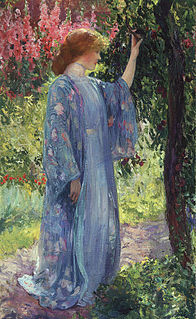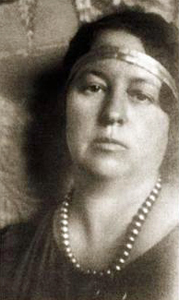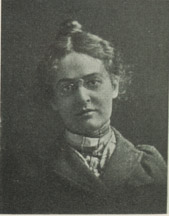
Anne Wardrope Brigman was an American photographer and one of the original members of the Photo-Secession movement in America.
The California Art Club (CAC) is one of the oldest and most active arts organizations in California. Founded in December 1909, it celebrated its centennial in 2009 and into the spring of 2010. The California Art Club originally evolved out of The Painters Club of Los Angeles, a short-lived group that lasted from 1906–09. The new organization was more inclusive, as it accepted women, sculptors and out-of-state artists.

Theodore Nikolai Lukits was a Romanian American portrait and landscape painter. His initial fame came from his portraits of glamorous actresses of the silent film era, but since his death, his Asian-inspired works, figures drawn from Hispanic California and pastel landscapes have received greater attention.
Charles Fremont Conner (1857–1905) was an American artist who was one of the most important painters in the Richmond Group in Richmond, Indiana.

Colin Campbell Cooper, Jr. was an American Impressionist painter, perhaps most renowned for his architectural paintings, especially of skyscrapers in New York City, Philadelphia, and Chicago. An avid traveler, he was also known for his paintings of European and Asian landmarks, as well as natural landscapes, portraits, florals, and interiors. In addition to being a painter, he was also a teacher and writer. His first wife, Emma Lampert Cooper, was also a highly regarded painter.

Leon Dabo was an American tonalist landscape artist best known for his paintings of New York, particularly the Hudson Valley. His paintings were known for their feeling of spaciousness, with large areas of the canvas that had little but land, sea, or clouds. During his peak, he was considered a master of his art, earning praise from John Spargo, Bliss Carman, Benjamin De Casseres, Edwin Markham, and Anatole Le Braz. His brother, Scott Dabo, was also a noted painter.
Peter Seitz Adams is an American artist. His body of work focuses on landscapes and seascapes created en plein air in oil or pastel as well as enigmatic figure and still-life paintings. He is noted for his colorful, high-key palette and broad brushwork. Adams has held numerous solo and group exhibitions in galleries and museums, including throughout California, the Western United States, and on the East Coast in Philadelphia, Vermont, and New York. Adams is the longest serving President of the California Art Club and has served on its board of directors in Pasadena, California from 1993 to 2018. He is also a writer on subjects relating to historic artists for the California Art Club Newsletter, as well as for a number of the organization's exhibition catalogs.

The terms California Impressionism and California Plein-Air Painting describe the large movement of 20th century California artists who worked out of doors, directly from nature in California, United States. Their work became popular in the San Francisco Bay Area and Southern California in the first three decades after the turn of the 20th century. Considered to be a regional variation on American Impressionism, the painters of the California Plein-Air School are also described as California Impressionists; the terms are used interchangeably.
Tim Solliday is a contemporary California Plein-Air Painter and Western Artist who is known for his San Gabriel Valley landscapes and his paintings of American Indians and other western subjects. He studied with the California Impressionist portrait and landscape painter Theodore Lukits (1897–1992) in the 1970s and began working professionally in the early 1980s. Solliday is described as a painter with a "muscular, masculine style" and has been compared to artists of the Taos Ten, especially E. Martin Hennings. He is a Signature Member of the California Art Club. He exhibits with the Laguna Plein-Air Painters Association, the Oil Painters of America and at the Maynard Dixon Invitational, which is held in Utah each year. Solliday's work has been featured in a number of American art magazines such as Southwest Art, American Artist and Art of the West. Through his plein-air work in the pastel medium and large canvasses, he has played an important role in the revival of landscape painting in Southern California.

Decorative Impressionism is an art historical term that is credited to the art writer Christian Brinton, who first used it in 1911. Brinton titled an article on the American expatriate painter Frederick Carl Frieseke, one of the members of the famous Giverny Colony of American Impressionists, "The Decorative Impressionist."

Arthur Putnam was an American sculptor and animalier who was recognized for his bronze sculptures of wild animals. Some of his artworks are public monuments. He was a well-known figure, both statewide and nationally, during the time he lived in California. Putnam was regarded as an artistic genius in San Francisco and his life was chronicled in the San Francisco and East Bay newspapers. He won a gold medal at the 1915 San Francisco world's fair, officially known as the Panama-Pacific International Exposition, and was responsible for large sculptural works that stand in San Francisco and San Diego. Putnam exhibited at the Armory Show in 1913, and his works were also exhibited in New York, Philadelphia, Chicago, Paris, and Rome.

Anne Bremer was a California painter, influenced by Post-Impressionism, who was called "the most 'advanced' artist in San Francisco" in 1912 after art studies in New York and Paris. She was described in 1916 as “one of the strong figures among the young moderns” and later as “a crusader for the modern movement.” She had numerous solo exhibitions, including one in New York.

Joseph Theodore "Waáno-Gano" ("Joe") Noonan of the San Fernando Valley Professional Artists' Guild was an artist born on March 3, 1906 in Salt Lake City, Utah. He self-identified as being of Cherokee descent.
Karl Dempwolf is a contemporary California Plein-Air Painter who is known for his California Landscapes. He is a Signature Member of the California Art Club, and serves in its Advisory Board of Directors.

Jessie Hazel Arms Botke was an Illinois and California painter noted for her bird images and use of gold leaf highlights.

Frances Gearhart was an American printmaker and watercolorist known for her boldly drawn and colored woodcut and linocut prints of American landscapes. Focused especially on California's coasts and mountains, this body of work has been called "a vibrant celebration of the western landscape." She is one of the most important American color block print artists of the early 20th century.

William (Billy) Posey Silva, habitually cited as William Silva (1859–1948), was an early 20th century American painter noted for atmospheric landscapes painted in a lyrical impressionist style. His work is associated with the Charleston Renaissance and with the art colony in Carmel, California, where he lived for thirty-six years.
The Painters’ Club of Los Angeles was a short-lived arts organization that existed from 1906-1909, and allowed only men as members. When the group disbanded a number of artists who had been members reorganized themselves as the California Art Club, including Charles Percy Austin (1883-1948), Franz Bischoff (1864-1929), Carl Oscar Borg (1879-1947), Benjamin Brown (1865-1942), Hanson Puthuff (1875-1972), Jack Wilkinson Smith (1873-1949), and William Wendt (1845-1946). Beginning with its founding in December 1909, the new California Art Club widened its membership guidelines to include female painters and sculptors of any gender.
Nell Brooker Mayhew was an American painter, etcher and art instructor.

Art Students League of Los Angeles was a modernist painting school that operated in Los Angeles, California from 1906 to 1953.